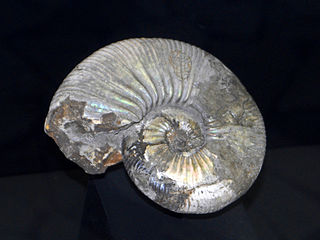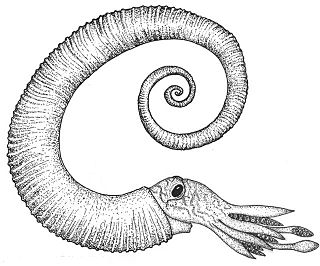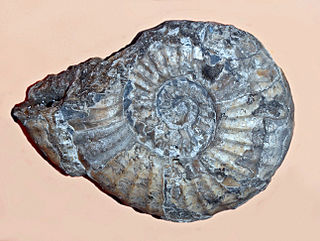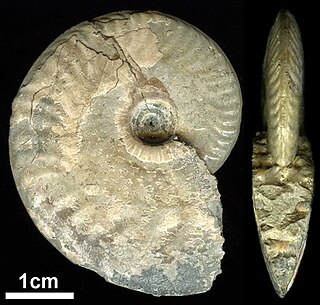
Ammonoids are extinct spiral shelled cephalopods comprising the subclass Ammonoidea. They are more closely related to living coleoids than they are to shelled nautiloids. The earliest ammonoids appeared during the Devonian, with the last species vanishing during or soon after the Cretaceous–Paleogene extinction event. They are often called ammonites, which is most frequently used for members of the order Ammonitida, the only remaining group of ammonoids from the Jurassic up until their extinction.

Goniatids, informally goniatites, are ammonoid cephalopods that form the order Goniatitida, derived from the more primitive Agoniatitida during the Middle Devonian some 390 million years ago. Goniatites (goniatitids) survived the Late Devonian extinction to flourish during the Carboniferous and Permian only to become extinct at the end of the Permian some 139 million years later.

Ammonitida or "True ammonites" are an order of ammonoid cephalopods that lived from the Jurassic through Paleocene time periods, commonly with intricate ammonitic sutures.

Acanthohoplites is an extinct genus of ammonites in the family Parahoplitidae that lived in the Aptian and Early Albian stages of the Early Cretaceous.

Anagaudryceras is an extinct genus of ammonite from the later Cretaceous belonging to the Ammonoidea family Gaudryceratidae. Anagaudryceras has a moderately involute shell with a deep umbilicus and strongly ribbed outer whorl. Ribs are thick and rounded and cross over the venter uninterrupted.

Audaxlytoceras is an extinct genus of lytoceratid ammonites.

Ceratitida is an order that contains almost all ammonoid cephalopod genera from the Triassic as well as ancestral forms from the Upper Permian, the exception being the phylloceratids which gave rise to the great diversity of post-Triassic ammonites.

Goniatitina is one of two suborders included in the order Goniatitida; extinct Paleozoic ammonoid cephalopods only distantly related to the Nautiloidea.

Turrilitoidea is a diverse superfamily of Cretaceous ammonites generally considered as heteromorphic and commonly included in the suborder Ancyloceratina. Shells of this diverse group do not coil planospirally, as typical for most ammonites, but rather take on a variety of unique forms. Separation of Turrilitoidea along with Ptychoceratoidea and Scaphatoidea into a different suborder, Turrilitina, was proposed by Beznosov and Mikhailova in 1983 however this view is not accepted by most authors.

Agoniatitida, also known as the Anarcestida, is the ancestral order within the cephalopod subclass Ammonoidea originating from bactritoid nautiloids, that lived in what would become Africa, Asia, Australia, Europe, and North America during the Devonian from about the lower boundary of Zlichovian stage into Taghanic event during upper middle Givetian, existing for approximately 25 million years.

Acanthoceratoidea, formerly Acanthocerataceae, is a superfamily of Upper Cretaceous ammonoid cephalopods belonging to the order Ammonitida, and comprising some 10 or so families.
The Danubitoidea is a large and diverse superfamily in the order Ceratitida of the Ammonoidea that combines five families removed from the Ceratitaceae, Clydonitaceae, and Ptychitaceae.

Arietitidae is a family of true ammonites that make up part of the superfamily Psiloceratoidea, named after the type genus Arietites. They comprise medium-size to large or gigantic genera which in general are strongly ribbed, tuberculate in some, with keeled or grooved and keeled venters, and well differentiated ammonitic sutures. The aptycus is single valved with a shiny, concentrically striated surface.

Oppeliidae are compressed to oxyconic, sculptured Haploceratoidea, either unkeeled, unicarinate, bicarinate, or tricarinate; with sutures in great variety, but ribbing usually more or less falcoid or falcate. The Oppeliidae is the principal family of the Haploceratoidea, with the longest duration, extending from the Middle Jurassic (Bajocian) to the Upper Cretaceous (Cenomanian) Their derivation is from the Hildoceratoidea.

The Aspidoceratidae comprise a family of middle and upper Jurassic ammonites that make up part of the superfamily Perisphinctoidea, characterized by evolute shells, commonly stocky, that tend to develop tubercles.

Desmoceratoidea, formerly Desmocerataceae, is a superfamily of Cretaceous ammonites, generally with round or oval-whorled shells that are mostly smooth or weakly ribbed and rarely tuberculate, but commonly with constrictions. Regarded as monophyletic, the Desmocerataceae are derived from the Phylloceratidae, splitting off in the Early Cretaceous (Valanginian) and persisting to the end of the Maastrichtian.

Hildoceratidae is a family of ammonoid cephalopods from the Lower Jurassic, lower Pliensbachian to lower Bajocian substages, generally with strongly ribbed, involute shells. They are combined with the Hammatoceratidae, Graphoceratidae, and Sonniniidae to make up the Hildoceratoidea.

Perisphinctidae is a family of Middle and Upper Jurassic discoidal ammonites in the order Ammonitida. They have a shell morphology that is mostly evolute, typically with biplicate, simple, or triplicate ribbing. Large forms have simple apertures and smooth body chambers while small forms have lappets and ribbed body chambers.
Sibiritidae constitutes a family of ceratitid ammonites described in the Treatise, Part L, 1957, as ribbed or tuberculate derivatives of Meekoceritidae with modification of the venter from mere widening and transverse ribbing to sulcation.
Goricanites is a ceratitid ammonoid cephalopod known only from the Lower Triassic Union Wash formation of California (USA). This fossil is included in the family Sibiritidae and subfamily Keyserlingitinae
















